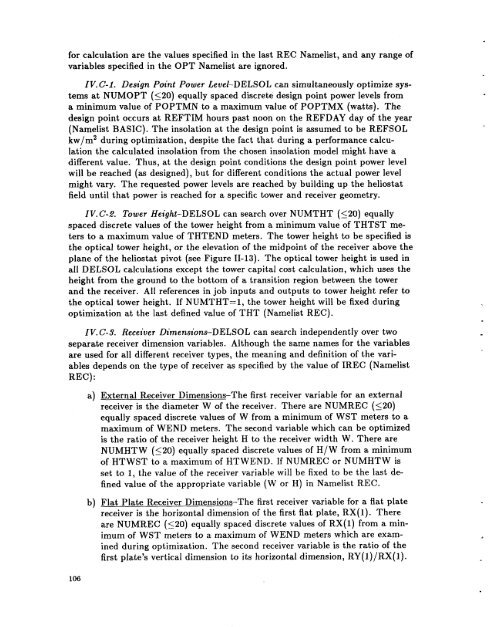A User's Manual for DELSOL3 - prod.sandia.gov - Sandia National ...
A User's Manual for DELSOL3 - prod.sandia.gov - Sandia National ...
A User's Manual for DELSOL3 - prod.sandia.gov - Sandia National ...
Create successful ePaper yourself
Turn your PDF publications into a flip-book with our unique Google optimized e-Paper software.
<strong>for</strong> calculation are the values specified in the last REC Namelist, and any range of<br />
variables specified in the OPT Namelist are ignored.<br />
IV. C-1. Design Point Power Level-DELSOL can simultaneously optimize sys-<br />
tems at NUMOPT (520) equally spaced discrete design point power levels from<br />
a minimum value of POPTMN to a maximum value of POPTMX (watts). The<br />
design point occurs at REFTIM hours past noon on the REFDAY day of the year<br />
(Namelist BASIC). The insolation at the design point is assumed to be REFSOL<br />
kw/m2 during optimization, despite the fact that during a per<strong>for</strong>mance calcu-<br />
lation the calculated insolation from the chosen insolation model might have a<br />
different value. Thus, at the design point conditions the design point power level<br />
will be reached (as designed), but <strong>for</strong> different conditions the actual power level<br />
might vary. The requested power levels are reached by building up the heliostat<br />
field until that power is reached <strong>for</strong> a specific tower and receiver geometry.<br />
IV. C-2. Tower Height-DELSOL can search over NUMTHT (520) equally<br />
spaced discrete values of the tower height from a minimum value of THTST me-<br />
ters to a maximum value of THTEND meters. The tower height to be specified is<br />
the optical tower height, or the elevation of the midpoint of the receiver above the<br />
plane of the heliostat pivot (see Figure 11-13). The optical tower height is used in<br />
all DELSOL calculations except the tower capital cost calculation, which uses the<br />
height from the ground to the bottom of a transition region between the tower<br />
and the receiver. All references in job inputs and outputs to tower height refer to<br />
the optical tower height. If NUMTHT=l, the tower height will be fixed during<br />
optimization at the last defined value of THT (Namelist REC).<br />
IV. C-3. Receiver Dimensions-DELSOL can search independently over two<br />
separate receiver dimension variables. Although the same names <strong>for</strong> the variables<br />
are used <strong>for</strong> all different receiver types, the meaning and definition of the vari-<br />
ables depends on the type of receiver as specified by the value of IREC (Namelist<br />
REC) :<br />
106<br />
a) External Receiver Dimensions-The first receiver variable <strong>for</strong> an external<br />
receiver is the diameter W of the receiver. There are NUMREC (520)<br />
equally spaced discrete values of W from a minimum of WST meters to a<br />
maximum of WEND meters. The second variable which can be optimized<br />
is the ratio of the receiver height H to the receiver width W. There are<br />
NUMHT W (520) equally spaced discrete values of H/ W from a minimum<br />
of HTWST to a maximum of HTWEND. If NUMREC or NUMHTW is<br />
set to 1, the value of the receiver variable will be fixed to be the last de-<br />
fined value of the appropriate variable (W or H) in Namelist REC.<br />
b) Flat Plate Receiver Dimensions-The first receiver variable <strong>for</strong> a flat plate<br />
receiver is the horizontal dimension of the first flat plate, RX(1). There<br />
are NUMREC (520) equally spaced discrete values of RX(1) from a min-<br />
imum of WST meters to a maximum of WEND meters which are exam-<br />
ined during optimization. The second receiver variable is the ratio of the<br />
first plate’s vertical dimension to its horizontal dimension, RY( 1)/RX( 1).

















